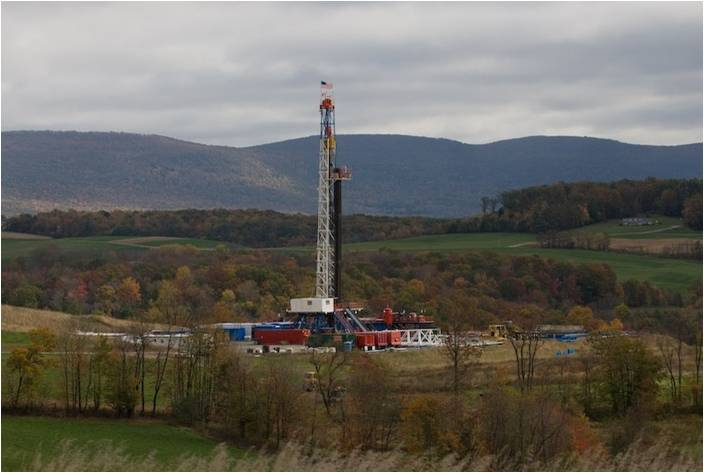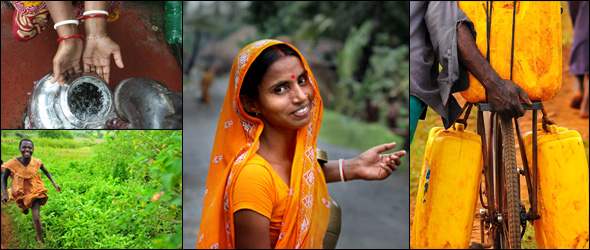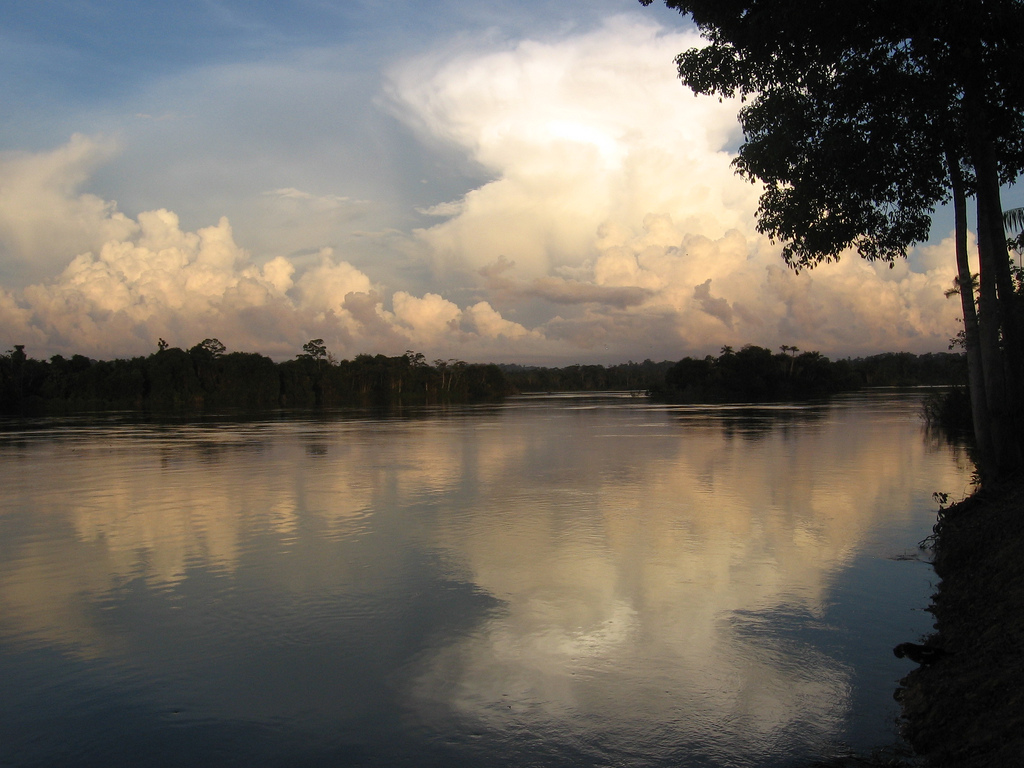Study: Shale Gas Fracking Taints Rivers in Pennsylvania
Though groundwater gets most of the attention, rivers are also affected by the rush of shale gas development across the United States, according to a new study that claims both wastewater and well development degrade water quality, but in different ways.

By Brett Walton
Circle of Blue
A study published last week in the Proceedings of the National Academy of Sciences (PNAS) shows how two pollutants associated with shale gas — chloride and total suspended solids — enter rivers and streams.
–Tom Barnard, water consultant
Used in nine out of 10 natural gas wells in the United States, hydraulic fracturing, or “fracking,” is a process in which millions of gallons of water, sand, and chemicals are pumped deep underground to break apart shale formations to release the natural gas trapped within the rock. There is concern that the chemicals used in fracking may contaminate groundwater and that the fracking process itself causes methane to seep into wells. The U.S. Environmental Protection Agency is currently conducting a study — to be released in 2014 — regarding the effects of fracking on drinking water.
Typically, groundwater gets most of the attention in the fracking debate, but rivers are also affected by the rush of shale gas development across the United States, according to Resources for the Future, a Washington, D.C.-based think tank, which is responsible for the PNAS study.
Researchers looked at two pollutant sources:
- the facilities that treat wastewater from gas development
- the well pads from which drilling takes place
Wastewater Treatment and Chloride Connection
The team found that adding more treatment plants in a watershed increases chloride concentrations downstream, but it does not affect total suspended solids (TSS), a measure of sediment and small particles in water.
–Brian Rahm, researcher
New York State Water Resources Institute
Cornell University
Chloride is found in flowback water, the liquid that spews out of a well after it has been hydraulically fractured to release natural gas. Between 10 percent and 70 percent of the millions of gallons of water that are pumped into the ground literally ‘flows back’ to the surface, along with naturally occurring heavy metals and salts that were picked up underground, in addition to the chemicals that were used in the fracking fluid.
Most of this wastewater is trucked to treatment plants, but chloride is difficult to remove with standard treatment technologies, especially those used at municipal facilities.
The PNAS study found that, on average, an additional 1.5 treatment plants in a watershed led to an increase in chloride levels by 10 percent downstream.
Well Pads and Total Suspended Solids
Well pads have a different effect. The study looked at the period in which land is cleared and the well is constructed — in other words, the time in which dirt is moved and when it could wash into rivers. Well pads, it turns out, do not increase chloride contamination, but they do raise TSS downstream. High TSS levels harm rivers by decreasing the amount of dissolved oxygen, raising water temperatures and blocking sunlight. They can also clog pipes and other infrastructure in the water.
The study found that adding 18 well pads in a watershed increases observed TSS concentrations by 5 percent.
The authors used more than 20,000 water quality observations in Pennsylvania between January 2000 and December 2011, a time period that extends well before deep shale gas development began in the state. They plotted the location of nearly 5,000 individual wells. But lead author Sheila Olmstead cautions that this study looks at average effects, not the contamination from any particular well.
“On average, we do see systematic effects across all watersheds,” Olmstead told Circle of Blue, adding that the results could help shape federal and state regulations.
The U.S. Energy Policy Act of 2005, for example, exempts most construction activities for oil and gas development from the Clean Water Act.
“Maybe we need to rethink that, if the well sites are causing water quality problems downstream,” Olmstead said.
As if on cue, energy companies agreed on Wednesday to a set of voluntary standards for fracking operations in Ohio, Pennsylvania, and West Virginia, the Associated Press reports. New York is also included, but the state has so far banned fracking within its borders. The standards — to be overseen by an independent board — guide wastewater disposal, groundwater protection, and well design, among others.
Brian Rahm, a researcher at the New York State Water Resources Institute at Cornell University, reviewed a draft copy of the PNAS paper. He told Circle of Blue that the study’s conclusions about sediment pollution are particularly important because of the pace of shale gas development: roughly 4,000 well pads — each the size of several football fields — have been built in Pennsylvania since 2008.
Rivers Neglected in the Shale Gas Debate
In the debate about groundwater contamination from methane and the media attention dedicated to the few salacious bursts of flammable well water, Pennsylvania’s rivers and streams have received scant attention, Tom Barnard told Circle of Blue.
“Surface water quality hasn’t really been the focus of the popular press or the scientific community,” said Barnard, a water consultant and a part-time researcher with the Institute for Energy and Environmental Research at Wilkes University in northeastern Pennsylvania. “The focus is on the injection of chemicals in groundwater and then on air quality. Surface water comes third.”
A group of shale gas experts — surveyed by Resources for the Future as part of the same Sloan Foundation grant that funded the PNAS study — shared the opinion that surface water has been neglected.
–Sheila Olmstead, lead author
PNAS study, Resources for the Future
More than 200 representatives from government, industry, academia, and NGO groups were asked what areas deserve the most attention in order to reduce environmental and health risks from shale gas development. In the February 2013 report Pathways to Dialogue, 12 risk areas were cited most frequently and seven of those related to surface water quality. The only two risks unique to shale gas — in other words, not shared by conventional gas development — also involved surface water quality.
The results of the PNAS study can lead new research in many directions, Olmstead said. While the study identifies river pollution from shale gas, it does not assess the ecological effects of adding more chloride and sediment. Being an economist, Olmstead wants to look next at the monetary costs of water quality.
“How do you trade off the benefits of shale gas with these effects on rivers?” she asked.
Rahm, who studies water quality in the Marcellus Shale region, cited this pragmatic approach as one of the study’s strengths: public discussion about the effects of shale gas is rife with innuendo, and the research history is relatively short and dogged by conflicting numbers and agendas.
“This is the type of paper that develops a constructive dialogue,” he said. “It acknowledges that there will be some impacts for shale gas. But is this something we find acceptable?”
Brett writes about agriculture, energy, infrastructure, and the politics and economics of water in the United States. He also writes the Federal Water Tap, Circle of Blue’s weekly digest of U.S. government water news. He is the winner of two Society of Environmental Journalists reporting awards, one of the top honors in American environmental journalism: first place for explanatory reporting for a series on septic system pollution in the United States(2016) and third place for beat reporting in a small market (2014). He received the Sierra Club’s Distinguished Service Award in 2018. Brett lives in Seattle, where he hikes the mountains and bakes pies. Contact Brett Walton







Leave a Reply
Want to join the discussion?Feel free to contribute!